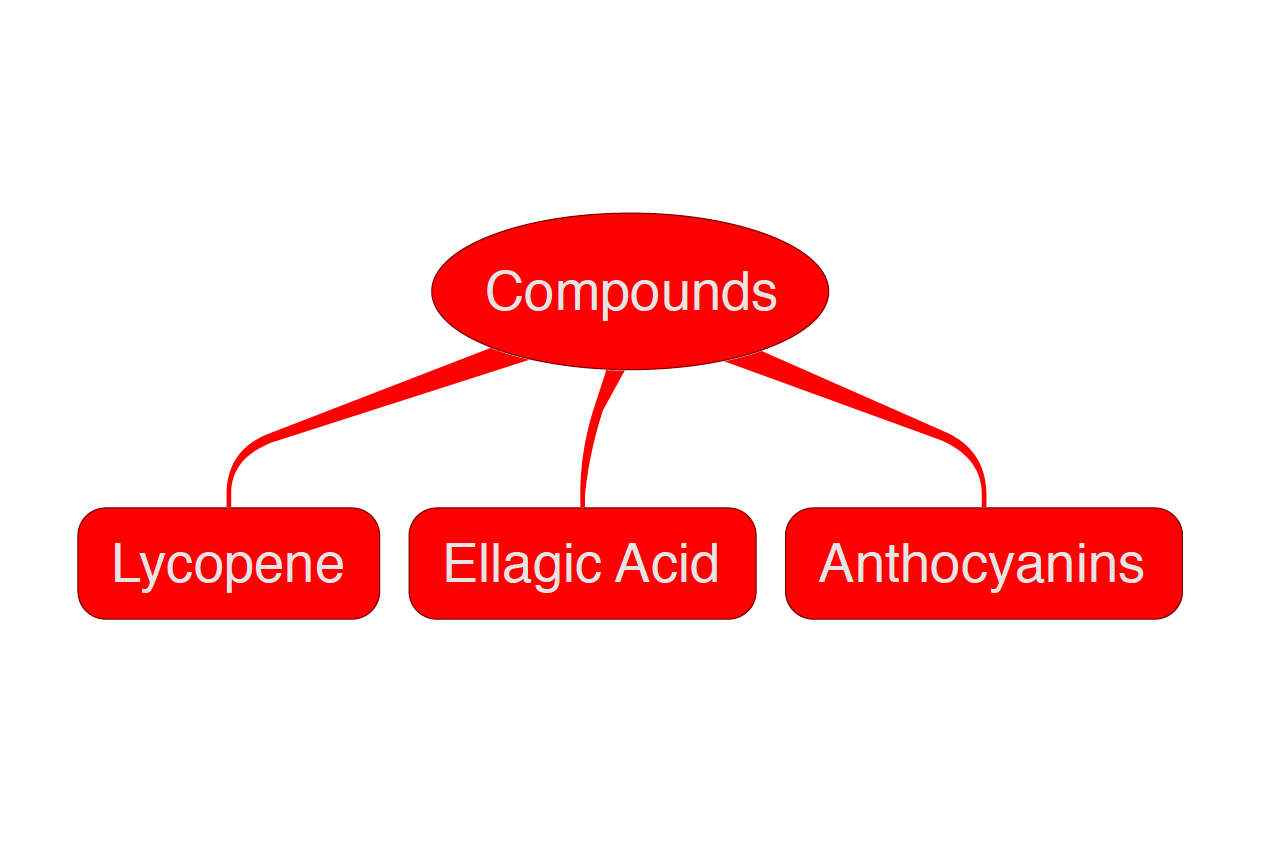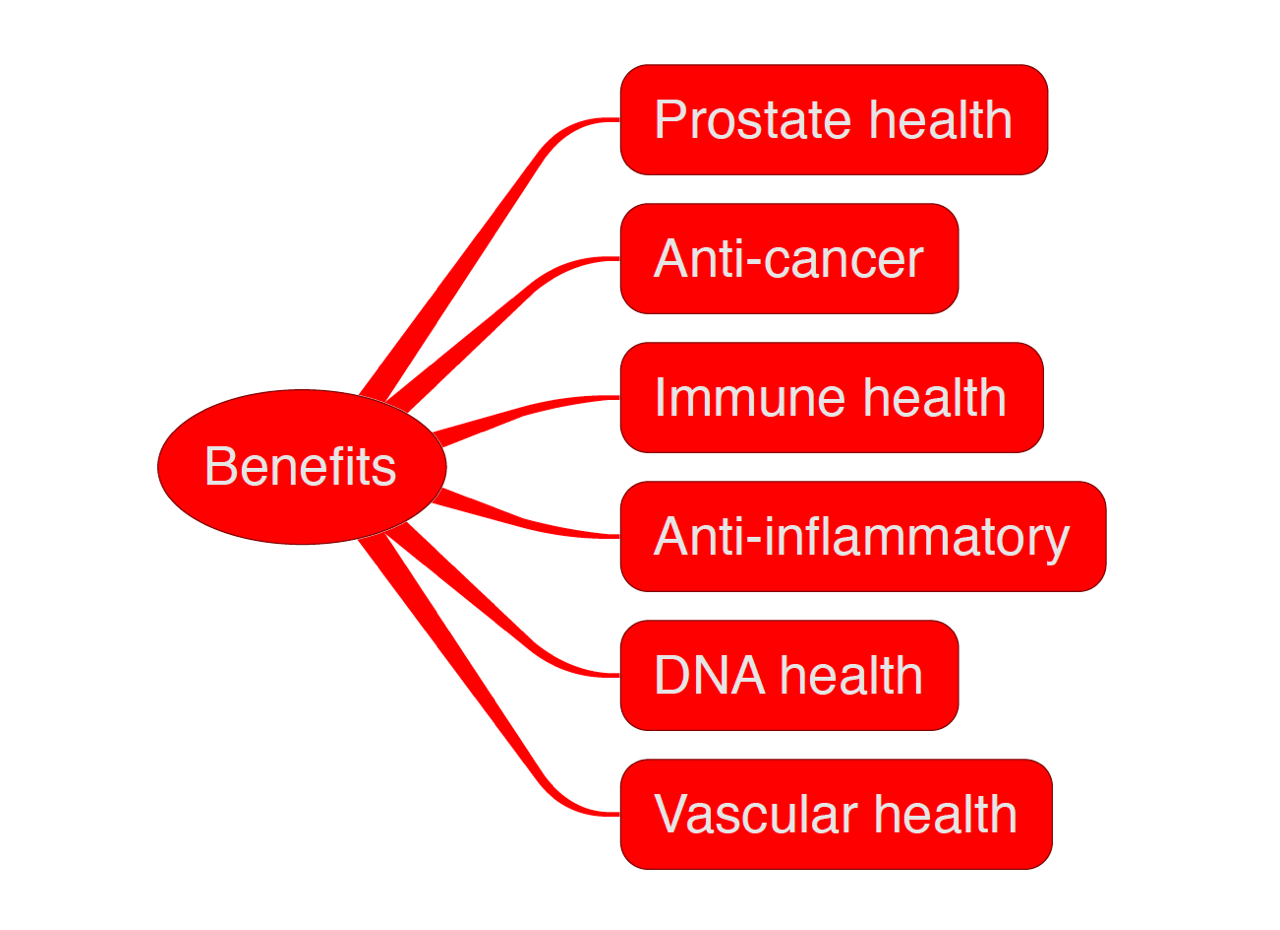Red, the blood of angry men,
Black, the dark of ages past,
Red, a world about to dawn,
Black, a night that ends at last.
Red is such a moody color, so crazy, so cupid, so cruel. It’s the color of love, the color of war. The color of roses, the color of pricked fingers. It's the color of Communism and the color of Republican Red States.
Are you confused yet?
Don't worry. When I see red, I see something much less puzzling and more down to earth: I see the color of prostate-healthy food.
Red Tales
The story of Red is long, but I’ll keep it short. Let's truncate it down to just a few key compounds.

Lycopene
Lycopene gets a lot of press for its role in the prevention of prostate cancer (men take note), but did you know it is also protective against breast and skin cancer? And that it reduces the risk of heart attacks too?
Medical multitasking is typical of phytonutrients. They almost always have multiple molecular targets in the body. Which means we can’t be reductionistic in our thinking. We can’t boil nutrients down like pharmaceuticals: a pill for every ill. That paradigm is becoming increasingly outdated. The new paradigm is looking more like: a plant for many nutrients, a nutrient from many plants, and a nutrient for many ills.
Why not? Nature loves diversity. And the body loves redundancy. We appear to be adapted for multiplicity. I don’t think it will be long before the industrial era of monocrops and monotherapies will seem simplistic, even quaint, to those growing up in a new era of biodiversity and complexity.
So where do I get Lycopene? Here's a few good sources:
- Tomatoes (tomato paste, juice, soup, sauce, etc.)
- Pink grapefruit
- Watermelon
- Guava.
Note: more lycopene is released when tomatoes are cooked and combined with fat (witness the cultural wisdom of marinara sauce with olive oil, for example).

Ellagic Acid
Ever wonder why pomegranates are considered a superfood? Ellagic Acid is why. Research on Ellagic Acid points to a number of cancer-cracking possibilities for this compound.
The American Cancer Society admits that the results are promising, but it's cautious about making claims for Ellagic Acid just based on cell cultures, animal studies, and limited human trials. Okay. That’s good scientific method. But waiting until all the results are in before you personally decide to start eating better is not a good application of the scientific method:
-
In lab tests, Ellagic Acid appears to coax cancer cells to go through the apoptosis process (cell death process) without damaging healthy cells.
-
Rats fed a diet of 5% to 10% dark red berries, rich in Ellagic acid, showed reductions in the growth of precancerous cells and in tumor progression.
-
The Hollings Cancer Institute at the University of South Carolina conducted a double blind study on 500 cancer patients, which showed that Ellagic acid may induce G-arrest (the inhibition of cancer cell division) and apoptosis (cell death) for breast, pancreas, esophageal, skin, colon, and prostate cancer cells.
Other studies indicate possible roles for Ellagic acid in killing H. pylori bacteria (the cause of stomach ulcers), protecting liver function and detoxification, inhibiting carcinogens from binding to DNA, and reducing blood sugar levels.
Good sources of Ellagic Acid include:
- Raspberries
- Strawberries
- Cranberries
- Walnuts
- Pecans
- And of course, pomegranates.
Anthocyanins
I cover Anthocyanins more thoroughly in my post, What 88% of Us Are Missing. So, let me just say that Anthocyanins come in shades of Red and Blue here. And just like Red and Blue politicians, they (ideally) work together to keep us whole. Red Anthocyanins may help reduce the risk of many cancers as well as preserve heart and brain cells to give us many good years of ticking and thinking.
Good sources of red Anthocyanins include:
- Raspberries
- Cherries
- Strawberries
- Cranberries
- Apples with red skin
- Beets
- Red cabbage
- Purple onion
- Kidney beans
- Red beans
Get Out Your Red Pen and Make a List.
Here's a graphic to help get you started on your next red grocery list. Have fun with it. Go wild. These are not the only red foods out there.

All-righty then, could I interest you in some Pomegranate Pilaf for dessert?
Pomegranate Pilaf: The Forgotten Art of Whole-Food Dessert.

A picture is worth a hundred words here. I mean, look at it. It really is that simple. It's not even a recipe. It's more like a discovery, like the bare-naked local peach served so proudly at Chez Panisse in Berkeley, Ca.
There's an easy way and a hard way to open pomegranates. If you'd like to do it the easy way, check out this YouTube video. When you're done, you can eat the seeds by the spoonful!
Warning: My son gobbles this stuff like candy. We kinda have to manage him. Or we don't get any. :)
Yours in Health and Resilience,
